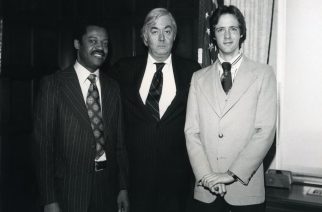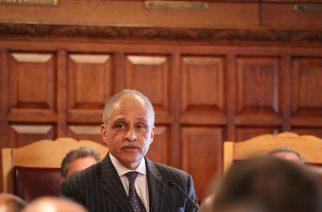
Governor Andrew Cuomo, right, is joined by former Vice President and environmental activist Al Gore, as the governor signs an aggressive climate change bill that will require a carbon-neutral economy in New York by 2050.
During a ceremony at Fordham Law School in Manhattan, Gov. Andrew Cuomo signed the Climate Leadership and Community Protection Act, with a goal of achieving a carbon-neutral economy by 2050.
Joined by former Vice President Al Gore, Cuomo called the legislation one of the the most consequential achievements of his administration.
“To deny climate change is to deny reality,” Cuomo said, making several references to the Trump Administration’s environmental policies. “Trump ignores climate change because it is not politically convenient to acknowledge it. This will be the most aggressive climate law in the United States of America”
Watch the bill signing here:
The legislation (S.6599/A.8429) was sponsored by Sen. Todd Kaminsky and Assemblyman Steve Englebright, who both chair the Environmental Conservation Committees in their respective houses.
The legislation includes aggressive mandates to require that New York achieves a 40-percent reduction in greenhouse gas emissions by 2030 and an 85-percent reduction in greenhouse gas emissions — with 100 percent carbon neutrality — by 2050.
In addition, the agreement codifies the governor’s goals to achieve 70 percent emissions-free electricity by 2030 and 100 percent emissions-free electricity by 2040.
The 2050 mandate exceeds reductions proposed under the Paris Climate Agreement and stands as the most comprehensive and aggressive climate bill ever enacted at the state level.
“This is the most well-crafted [environmental] legislation in the country,” Gore said. “This will set a new bar.”
To achieve these goals, the legislation requires that the state power grid procure at least nine gigawatts of offshore wind electric generation by 2035, six gigawatts of distributed photovoltaic solar generation by 2025, three gigawatts of statewide energy storage capacity by 2030, and 185 trillion BTUs of end-use energy savings below the 2025 energy use forecast.
To get the ball rolling, the state recently selected two companies to build two offshore wind farms for a combined total of 1,700 megawatts of clean energy – enough to power one million homes. The first is the Sunrise Wind project which will be constructed 30 miles east of Long Island and generate 880 megawatts for Long Island.
The second is the Empire Wind project, located 14 miles southeast of Manhattan, which will provide 816 megawatts for New York City.

This map shows the location of two offshore wind projects being planned to provide 1,700 megawatts of energy for Long Island and New York City as part of a new climate change law signed by the governor on July 18, 2019.
The governor said during his remarks Thursday that $287 million will be invested to construct manufacturing, service and port facilities in Port Jefferson, Brooklyn, Staten Island and the Capital Region.
“These projects will help make New York the hub for this industry,” Cuomo said.
In addition, New York will provide $20 million to develop a wind training program at several SUNY campuses.
The projects are expected to generate $3.2 billion in economic activity, and 1,600 construction and permanent jobs.
Port upgrades will begin in 2020. Construction of the onshore facilities will begin in 2022. Offshore construction will begin in late 2022 and the projects will be completed by 2024, Cuomo said.
The legislation also creates a new advisory council, comprised of experts in agriculture, housing, energy, manufacturing industry, transportation and land use — among other sectors — to help roll out the legislation’s provisions.
The bill passed the Legislature in the final days of session and was delivered to the governor on July 16.
“We still have a chance,” Gore said. “We have it within our power to grab hold of this crisis and save the future. We need leadership. We need new policies.
“It’s OK to change the light bulbs, but it’s better to change the laws.”









